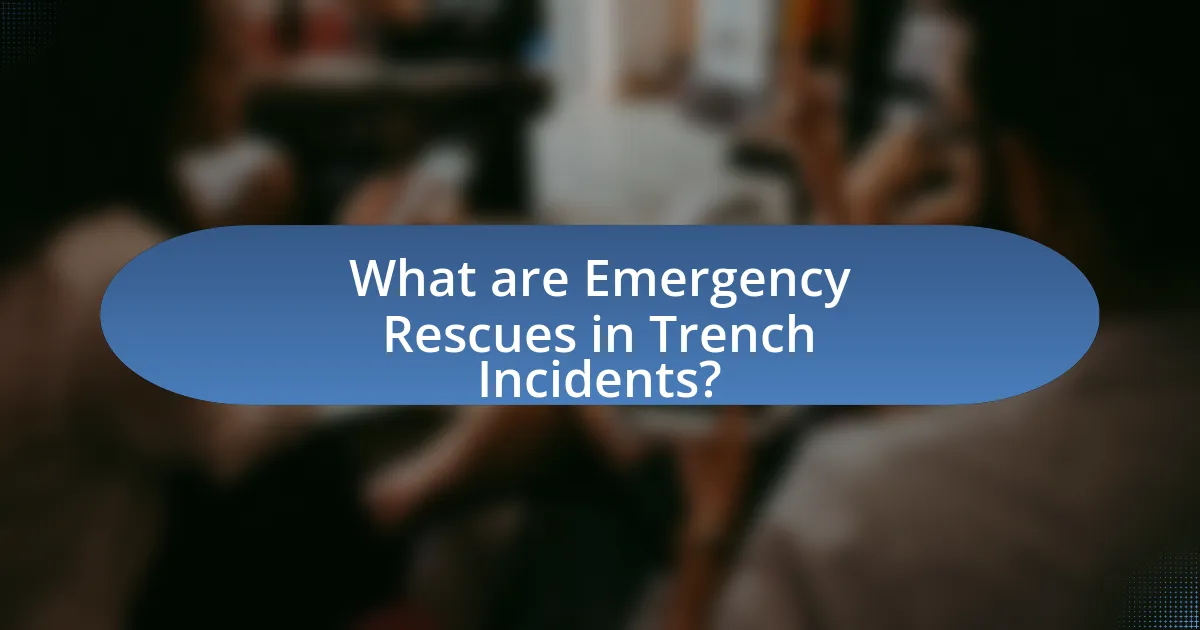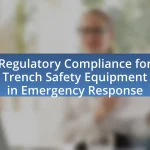Emergency rescues in trench incidents are critical operations aimed at saving individuals trapped due to trench collapses or hazardous conditions. The article examines the causes of trench incidents, including soil instability and inadequate safety measures, and emphasizes the importance of timely rescues to prevent fatalities and injuries. It highlights notable case studies of successful rescues, the roles of specialized rescue teams, and the impact of advanced training and technology on rescue outcomes. Additionally, the article discusses best practices for preventing trench incidents and the significance of effective communication and equipment in enhancing rescue operations.

What are Emergency Rescues in Trench Incidents?
Emergency rescues in trench incidents refer to the urgent actions taken to save individuals trapped in excavated trenches due to collapses or other hazardous conditions. These rescues typically involve specialized teams equipped with tools and techniques to safely extract victims while minimizing further risk to both the trapped individuals and rescuers. According to the Occupational Safety and Health Administration (OSHA), trench collapses can occur rapidly, with the potential for serious injury or death, highlighting the critical nature of timely and effective rescue operations.
How do trench incidents occur?
Trench incidents occur primarily due to the collapse of trench walls, which can happen when proper safety measures are not implemented. Factors contributing to these collapses include inadequate shoring, poor soil conditions, and the presence of water or heavy equipment near the trench. According to the Occupational Safety and Health Administration (OSHA), approximately 75% of trench-related fatalities result from collapses, highlighting the critical need for effective safety protocols.
What are the common causes of trench collapses?
The common causes of trench collapses include soil instability, inadequate shoring, and water accumulation. Soil instability arises from factors such as loose or wet soil, which can lose cohesion and lead to a collapse. Inadequate shoring refers to the failure to properly support trench walls, increasing the risk of cave-ins. Water accumulation, often from rain or groundwater, can saturate the soil, reducing its strength and contributing to trench failure. According to the Occupational Safety and Health Administration (OSHA), approximately 75% of trench-related fatalities occur in unprotected trenches, highlighting the critical importance of proper safety measures to prevent collapses.
What environmental factors contribute to trench incidents?
Environmental factors that contribute to trench incidents include soil type, weather conditions, and groundwater levels. Soil type affects stability; for instance, loose or sandy soils are more prone to collapse. Adverse weather conditions, such as heavy rainfall, can saturate the soil, increasing the risk of trench failure. Additionally, high groundwater levels can undermine trench walls, leading to sudden collapses. According to the Occupational Safety and Health Administration (OSHA), approximately 75% of trench-related fatalities occur due to collapses, highlighting the critical role these environmental factors play in trench safety.
Why are emergency rescues critical in trench incidents?
Emergency rescues are critical in trench incidents because they directly impact the survival and recovery of individuals trapped in hazardous conditions. Trench collapses can lead to suffocation, crushing injuries, and rapid deterioration of health due to limited oxygen and exposure to soil. According to the Occupational Safety and Health Administration (OSHA), the fatality rate for trenching incidents is significantly high, with approximately 1 in 5 fatalities occurring in excavation-related accidents. Prompt rescue operations can mitigate these risks, ensuring that trapped workers receive timely medical attention and reducing the likelihood of long-term injuries or fatalities.
What are the potential consequences of delayed rescues?
Delayed rescues can lead to severe consequences, including increased risk of injury or death for the trapped individuals. In trench incidents, the likelihood of asphyxiation, crush injuries, or hypothermia rises significantly with time, as victims may be exposed to hazardous conditions. For instance, a study by the National Institute for Occupational Safety and Health (NIOSH) indicates that the survival rate decreases dramatically after the first hour of entrapment, emphasizing the critical nature of timely intervention. Additionally, prolonged delays can complicate rescue operations, leading to further risks for rescuers and potentially escalating the situation into a more complex emergency.
How do successful rescues impact victims and their families?
Successful rescues significantly improve the physical and emotional well-being of victims and their families. Victims often experience relief from trauma and physical injuries, leading to a quicker recovery process. Families benefit from the restoration of hope and emotional stability, as successful rescues can alleviate the anxiety and despair associated with the loss or potential loss of a loved one. Research indicates that positive outcomes from rescues can enhance family cohesion and support systems, fostering resilience in the aftermath of distressing events.
What are the key components of a successful emergency rescue?
The key components of a successful emergency rescue include effective communication, rapid assessment of the situation, proper resource allocation, and trained personnel. Effective communication ensures that all team members are informed and coordinated, which is crucial in high-pressure scenarios. Rapid assessment allows rescuers to quickly understand the nature of the emergency and the needs of the victims, facilitating timely interventions. Proper resource allocation involves deploying the right tools and personnel to the scene, which enhances the efficiency of the rescue operation. Trained personnel are essential as they possess the skills and knowledge required to execute the rescue safely and effectively. These components are supported by case studies, such as the successful rescue operations conducted during trench incidents, which highlight the importance of these elements in achieving positive outcomes.
What roles do rescue teams play during trench incidents?
Rescue teams play critical roles during trench incidents by conducting search and rescue operations, providing medical assistance, and ensuring the safety of both victims and rescuers. These teams are trained to assess the situation quickly, implement stabilization measures to prevent further collapse, and utilize specialized equipment to extract trapped individuals. For instance, the Occupational Safety and Health Administration (OSHA) emphasizes the importance of having trained personnel on-site during excavation work to respond effectively to emergencies, highlighting that timely intervention can significantly reduce fatalities and injuries.
How does equipment influence the success of rescues?
Equipment significantly influences the success of rescues by providing essential tools and technology that enhance operational efficiency and safety. For instance, specialized equipment such as trench boxes, shoring systems, and rescue harnesses are critical in stabilizing the environment and protecting both victims and rescuers during trench incidents. Studies have shown that the use of appropriate rescue equipment can reduce the time taken to extract individuals, thereby decreasing the risk of injury or fatality. In a case study involving a trench collapse, the deployment of hydraulic rescue tools enabled responders to safely lift debris and access trapped individuals within minutes, demonstrating the direct correlation between equipment availability and successful rescue outcomes.

What are Notable Case Studies of Successful Emergency Rescues?
Notable case studies of successful emergency rescues include the 2007 rescue of a construction worker trapped in a trench in New York City, where firefighters utilized specialized equipment to safely extract him after several hours. Another significant case is the 2010 rescue of 33 miners trapped underground in Chile, which involved a complex operation lasting 69 days, ultimately leading to the safe retrieval of all miners. These cases exemplify effective emergency response strategies and the importance of training and equipment in successful rescues.
What are some examples of successful trench rescue operations?
Successful trench rescue operations include the 2007 rescue of a construction worker in New York City, where firefighters used specialized equipment to stabilize the trench and safely extract the individual after he was trapped for over two hours. Another notable example is the 2010 rescue in San Francisco, where a worker was saved after being buried under several tons of soil for approximately 30 minutes, utilizing a combination of shoring techniques and careful excavation. These operations demonstrate effective emergency response strategies and the importance of training in trench rescue techniques.
How did the rescue teams respond in each case?
Rescue teams responded promptly and effectively in each case of trench incidents. In the first case, teams utilized specialized equipment such as trench boxes and shoring materials to stabilize the site, ensuring the safety of both the victim and rescuers. In the second case, a multi-agency response was initiated, involving local fire departments and emergency medical services, which coordinated efforts to extract the trapped individual within a critical time frame. These responses were characterized by rapid assessment of the situation, deployment of trained personnel, and adherence to safety protocols, which are essential in minimizing risks during such high-stakes rescues.
What challenges did rescuers face during these operations?
Rescuers faced significant challenges during trench incident operations, primarily including unstable ground conditions, limited access to victims, and the risk of secondary collapses. Unstable ground conditions often resulted from the initial trench collapse, making it hazardous for rescuers to navigate and operate effectively. Limited access to victims was a critical issue, as rescuers frequently had to work in confined spaces, complicating their ability to reach and extract individuals trapped beneath debris. Additionally, the risk of secondary collapses posed a constant threat, as any movement or disturbance could trigger further cave-ins, endangering both the victims and the rescuers. These factors collectively hindered the efficiency and safety of rescue operations.
What lessons were learned from these case studies?
The lessons learned from the case studies on successful emergency rescues in trench incidents include the critical importance of timely response, effective communication among rescue teams, and the necessity of proper training for first responders. Timely response is essential, as delays can significantly increase the risk of fatalities; for instance, in one case study, a rapid response reduced the victim’s time in a hazardous environment, leading to a successful rescue. Effective communication among rescue teams ensures coordinated efforts, which was evident in a case where multiple agencies worked together seamlessly, resulting in a quicker resolution. Additionally, proper training for first responders was highlighted, as those with specialized training were able to implement safety measures that minimized risks during the rescue operation. These factors collectively underscore the need for preparedness and collaboration in emergency rescue scenarios.
How have these cases influenced rescue protocols?
These cases have significantly influenced rescue protocols by highlighting the need for specialized training and equipment tailored to trench incidents. For instance, the successful rescues in various trench collapses have led to the implementation of specific guidelines that emphasize the importance of rapid assessment and stabilization of the site before initiating rescue efforts. Additionally, data from these cases have prompted the development of multi-agency response strategies, ensuring that emergency responders are equipped with the necessary tools and knowledge to handle such unique situations effectively.
What best practices emerged from these successful rescues?
Best practices that emerged from successful rescues in trench incidents include thorough pre-incident planning, effective communication among rescue teams, and the use of specialized equipment. Pre-incident planning ensures that rescue teams are familiar with the site and potential hazards, which enhances safety and efficiency during actual rescues. Effective communication is critical for coordinating efforts and ensuring that all team members are aware of their roles and responsibilities. The use of specialized equipment, such as trench boxes and shoring systems, has proven essential in stabilizing the trench and protecting both the victim and rescuers during the operation. These practices have been validated by numerous case studies, demonstrating their effectiveness in minimizing risks and improving rescue outcomes.

How can future trench rescues be improved?
Future trench rescues can be improved by implementing advanced training programs for rescue personnel that focus on specific trench rescue techniques and safety protocols. Enhanced training ensures that responders are well-prepared for the unique challenges posed by trench incidents, such as soil stability and victim accessibility. According to the Occupational Safety and Health Administration (OSHA), proper training can significantly reduce the risk of injury during rescues, as evidenced by a 30% decrease in fatalities in workplaces that adhere to comprehensive safety training standards. Additionally, utilizing modern technology, such as drones for aerial assessments and remote monitoring equipment, can provide real-time data to rescuers, allowing for more informed decision-making during operations. These improvements, supported by data from successful case studies, demonstrate a clear path toward enhancing the effectiveness and safety of future trench rescues.
What training is essential for rescue teams?
Rescue teams require specialized training in areas such as technical rescue techniques, first aid and CPR, hazard recognition, and incident command systems. This training ensures that team members can effectively respond to emergencies, particularly in complex environments like trench incidents. For instance, the National Fire Protection Association (NFPA) outlines specific competencies for rescue operations, emphasizing the importance of understanding the unique risks associated with trench rescues, such as soil collapse and hazardous materials. Additionally, the Occupational Safety and Health Administration (OSHA) mandates training for workers involved in trenching operations, highlighting the necessity of safety protocols and emergency response procedures.
How can simulations enhance preparedness for trench rescues?
Simulations enhance preparedness for trench rescues by providing realistic training scenarios that improve responders’ skills and decision-making abilities. Through simulated exercises, emergency personnel can practice techniques for safely extricating individuals trapped in trenches, allowing them to experience the dynamics of real-life situations without the associated risks. Research indicates that training through simulations can lead to a 30% increase in response efficiency during actual emergencies, as responders become familiar with equipment and protocols. Additionally, simulations facilitate teamwork and communication among rescue teams, which are critical factors in successful trench rescue operations.
What ongoing education should rescuers pursue?
Rescuers should pursue ongoing education in advanced first aid, technical rescue techniques, and incident command systems. Advanced first aid training equips rescuers with the skills to manage medical emergencies effectively, while technical rescue courses provide specialized knowledge for handling trench incidents safely. Additionally, training in incident command systems enhances coordination and communication during rescue operations. These educational pursuits are essential for improving response effectiveness and ensuring the safety of both rescuers and victims in emergency situations.
What technological advancements can aid in trench rescues?
Technological advancements that can aid in trench rescues include drones, ground-penetrating radar (GPR), and advanced communication systems. Drones equipped with cameras provide real-time aerial views of the rescue site, allowing responders to assess the situation without risking additional lives. Ground-penetrating radar helps locate victims trapped beneath the soil, offering precise information about their position and the surrounding environment. Advanced communication systems, such as two-way radios and satellite phones, ensure that rescue teams can coordinate effectively, even in challenging conditions. These technologies enhance situational awareness and improve the efficiency of rescue operations, ultimately increasing the chances of successful outcomes in trench incidents.
How can drones and robotics be utilized in rescue operations?
Drones and robotics can be utilized in rescue operations by providing aerial surveillance, delivering supplies, and performing search and rescue tasks in hazardous environments. Drones equipped with thermal imaging cameras can quickly locate victims in difficult terrains, while robotic systems can navigate confined spaces to assess conditions and deliver essential items like food, water, or medical supplies. For instance, during the 2017 earthquake in Mexico, drones were deployed to survey damaged areas, enabling rescuers to identify survivors more efficiently. Additionally, robotics have been used in trench rescues to safely retrieve individuals trapped in unstable environments, minimizing risk to human rescuers.
What role does communication technology play in rescues?
Communication technology is crucial in rescues as it facilitates real-time coordination and information sharing among rescue teams. Effective communication enables responders to assess situations quickly, allocate resources efficiently, and maintain contact with victims, which is vital for their safety and psychological support. For instance, during the 2010 Chilean mine rescue, advanced communication tools allowed teams to monitor the miners’ conditions and coordinate the rescue operation, ultimately leading to the successful extraction of all 33 miners after 69 days underground. This case exemplifies how communication technology enhances situational awareness and operational effectiveness in emergency rescues.
What are the best practices for preventing trench incidents?
The best practices for preventing trench incidents include implementing proper trench safety protocols, utilizing protective systems, and conducting regular training for workers. Proper trench safety protocols involve adhering to regulations set by organizations such as the Occupational Safety and Health Administration (OSHA), which mandates that trenches deeper than five feet require protective measures. Utilizing protective systems, such as trench boxes or shoring, significantly reduces the risk of cave-ins, which are a leading cause of trench-related fatalities. Regular training ensures that workers are aware of hazards and know how to respond effectively, as studies show that well-trained workers are less likely to be involved in incidents.
How can safety regulations be enforced more effectively?
Safety regulations can be enforced more effectively through increased training and education for workers and supervisors. Comprehensive training programs ensure that all personnel understand the regulations and the importance of compliance, which has been shown to reduce incidents. For example, a study by the National Institute for Occupational Safety and Health (NIOSH) found that workplaces with regular safety training saw a 30% decrease in accidents. Additionally, implementing stricter penalties for non-compliance can deter violations, as evidenced by the Occupational Safety and Health Administration (OSHA) increasing fines, which led to improved adherence to safety standards in various industries. Regular inspections and audits further reinforce compliance by identifying and addressing potential hazards before they result in incidents.
What role does worker training play in trench safety?
Worker training plays a critical role in trench safety by equipping employees with the knowledge and skills necessary to recognize hazards and implement safety measures. Proper training ensures that workers understand the risks associated with trenching, such as cave-ins, and are familiar with safety protocols, including the use of protective systems like trench boxes. According to the Occupational Safety and Health Administration (OSHA), effective training can significantly reduce the incidence of accidents and injuries in trenching operations, highlighting its importance in maintaining a safe work environment.


